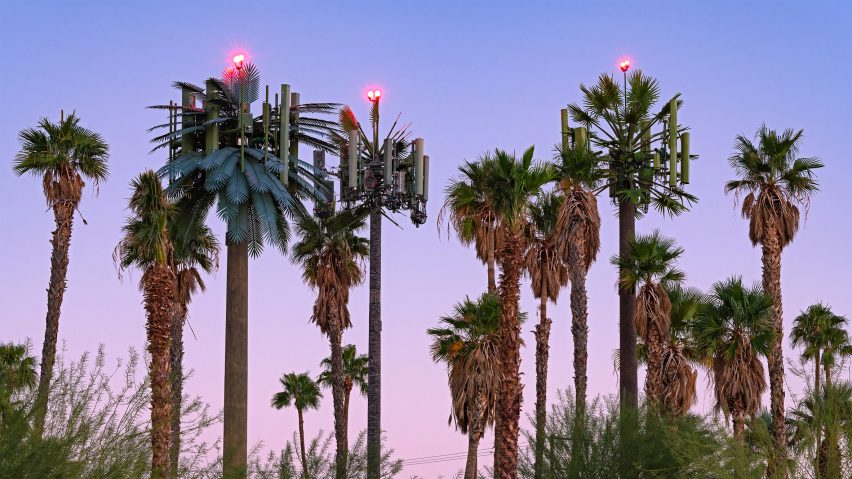American photographer Annette LeMay Burke's book Fauxliage showcases cell towers that have been designed to blend into their surroundings, including a pine tree in the middle of the desert, airbrushed cacti and church crosses.
The photographer traversed the American west to document the camouflaged mobile phone masts, which have fascinated her since she first came across cell tower "trees" in the early 2000s.
The towers, which house antennas and electronic equipment for mobile phones, in her book were designed to look less conspicuous against the often stark landscape than regular masts.
"Initially, I was simply amused by their appearances," Burke told Dezeen.
"Then I noticed that instead of providing camouflage, the disguises actually drew attention to their true identities. I began to investigate the variety of forms and realised how technology was modifying our environment."
For Fauxliage, a combination of the words faux and foliage, she chose 66 masts to showcase, most of which are in California, Arizona and Nevada.
Each of the disguises are dependent on the climate, she explained, with palm tree cell towers located in the warmer regions and pine tree cell towers in colder climates.
While some of the images in the book show sci-fi-esque palm trees with fake fronds supplemented by metal boxes, other mobile phone companies have gone to greater lengths to hide their towers.
In one case three cell towers have been disguised as plain crosses outside an unadorned Baptist church.
"I think the strangest ones are the church crosses, a true mixing of religion and commerce," said Burke.
Other cell towers featured in Fauxliage have been painstakingly detailed to blend into their surroundings so they are hard to spot from a distance.
"My favourites are the saguaro cacti," Burke said.
"The detailed workmanship in the disguises is impressive. The cactus spine spots are all individually airbrushed and the designers have even created dark patches that mimic the bird nest burrows."
According to Burke, the first-ever disguised cell tower was a pine tree in Denver, Colorado, created in 1992.
"The designer, Larson Camouflage [now Valmont Concealment Structures], initially created manufactured landscapes for Disneyland, zoos, and natural history museums," Burke said.
Since then, the trees with their man-made adornments have become an environmental problem, and their disguises also make the towers more expensive according to Burke.
"Both the manufactured branches and the reinforcement to handle the extra weight of the branches add around $100,000 to the typical evergreen," she explained.
The evergreens are especially bad for the environment, as their plastic needles fall off the trees and litter the ground below when the cell tower trees start to age and weather.
"The small plastic pieces could easily enter the ecosystem," Burke said. "What started as an attempt to minimise visual pollution, is now causing plastic pollution."
However, Burke believes the trees might soon start to disappear from the Western landscape as technology evolves and smaller 5G-towers take their place.
"I do think they will start disappearing, due to changing technology, camouflage costs, and our visual tolerance to cell towers in the built environment," she said.
"I have personally noticed many trees switch from disguised to undisguised. With the cellular tower terrain in flux, I felt it was important to document them now," Burke said.
Other recent photography books to document the built environment include Robert Rieger and Felix Brüggemann's farewell to Berlin's brutalist Tegel airport and Nikola Olic's urban photography series Structure Photography.
Photography is by Annette LeMay Burke. Fauxliage by Annette LeMay Burke is published by Daylight Books.
Fauxliage will launch with an online event at the Center for Photographic Art in Carmel, California on 7 May. See Dezeen Events Guide for an up-to-date list of architecture and design events taking place around the world.

